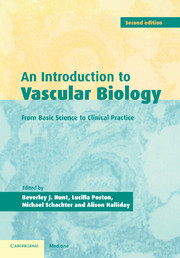Book contents
- Frontmatter
- Contents
- List of contributors
- Preface
- Part I Basic science
- Part II Pathophysiology: mechanisms and imaging
- Part III Clinical practice
- 12 Vascular biology of hypertension
- 13 Atherosclerosis
- 14 Abdominal aortic aneurysm
- 15 The vasculature in diabetes
- 16 The vasculitides
- 17 Pulmonary hypertension
- 18 Role of endothelial cells in transplant rejection
- 19 Vascular function in normal pregnancy and preeclampsia
- Index
13 - Atherosclerosis
Published online by Cambridge University Press: 07 September 2009
- Frontmatter
- Contents
- List of contributors
- Preface
- Part I Basic science
- Part II Pathophysiology: mechanisms and imaging
- Part III Clinical practice
- 12 Vascular biology of hypertension
- 13 Atherosclerosis
- 14 Abdominal aortic aneurysm
- 15 The vasculature in diabetes
- 16 The vasculitides
- 17 Pulmonary hypertension
- 18 Role of endothelial cells in transplant rejection
- 19 Vascular function in normal pregnancy and preeclampsia
- Index
Summary
Introduction
Atherosclerosis continues to be a leading cause of mortality and morbidity throughout the world. It has until recently been thought of as a degenerative disease, affecting predominantly older people, with progression over several decades, and eventually leading to symptoms through its mechanical effects on blood flow, particularly in the small-calibre arteries supplying the myocardium and brain. Because of the perceived insidious and relentless nature of its development, there has been a somewhat pessimistic view of the potential to modify its progression by medical therapy, and treatment has instead been dominated by interventional revascularization approaches, targeting the largest and most visible or symptomatic lesions with angioplasty or bypass surgery. There has been little emphasis on the diagnosis and quantification of subclinical disease, or the treatment of high-risk, asymptomatic patients. Recently, this defeatist view of the pathogenesis and progression of atherosclerosis has begun to change, firstly, because careful descriptive studies of the underlying pathology of atherosclerosis have revealed that atherosclerotic plaques differ in their cellular composition, and that the cell types predominating in the plaque can determine the risk of a fatal clinical event such as myocardial infarction or stroke. Secondly, cellular and molecular biological studies, particularly involving transgenic mice, have emphasized the importance of inflammatory cells and inflammatory mediators in the pathogenesis of atherosclerosis.
- Type
- Chapter
- Information
- An Introduction to Vascular BiologyFrom Basic Science to Clinical Practice, pp. 302 - 317Publisher: Cambridge University PressPrint publication year: 2002
- 3
- Cited by

